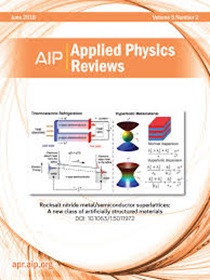生物系统的纳米级成像通过扩展和超分辨率显微镜
IF 11.6
1区 物理与天体物理
Q1 PHYSICS, APPLIED
引用次数: 0
摘要
超分辨率显微镜(SRM)突破了衍射极限,实现了纳米级生物结构的可视化,为生命科学带来了革命性的变化。膨胀显微镜(ExM)是一种功能强大且易于使用的技术,它通过物理放大标本来提高分辨率。重要的是,ExM 的原理为与 SRM 方法的结合提供了独特的基础,推动了可实现分辨率的极限。本综述探讨了 ExM 的基本原理,并研究了它与各种 SRM 技术的成功结合,包括基于荧光波动的 SRM、结构照明显微镜、受激辐射耗竭显微镜和单分子定位显微镜。我们讨论了这些组合方法的应用、优势、局限性和分辨率,为研究人员选择最适合其特定科学需求的方法提供了全面指导。将 ExM 与 SRM 结合使用时的主要考虑因素包括对荧光团的影响、对专用缓冲液的要求以及膨体水凝胶对温度和水合作用的敏感性所带来的挑战。文中详细讨论了应对这些挑战的策略,如优化标记技术和凝胶再嵌入。本综述旨在帮助研究人员驾驭快速发展的 ExM 和 SRM,促进量身定制的成像管线的开发,从而增进我们对纳米尺度生物系统的了解。本文章由计算机程序翻译,如有差异,请以英文原文为准。
Nanoscale imaging of biological systems via expansion and super-resolution microscopy
Super-resolution microscopy (SRM) has revolutionized life sciences by overcoming the diffraction limit, enabling the visualization of biological structures at the nanoscale. Expansion Microscopy (ExM) has emerged as a powerful and accessible technique that enhances resolution by physically enlarging the specimen. Importantly, the principles of ExM provide a unique foundation for combinations with SRM methods, pushing the boundaries of achievable resolution. This review explores the fundamental principles of ExM and examines its successful integration with various SRM techniques, including fluorescence fluctuation-based SRM, structured illumination microscopy, stimulated emission depletion microscopy, and single-molecule localization microscopy. We discuss the applications, strengths, limitations, and resolutions achieved by these combined approaches, providing a comprehensive guide for researchers to select the most suitable method for their specific scientific needs. Key considerations when combining ExM with SRM include the impact on fluorophores, the requirement for specialized buffers, and the challenges posed by the sensitivity of expanded hydrogels to temperature and hydration. Strategies to address these challenges, such as optimized labeling techniques and gel re-embedding, are discussed in detail. This review aims to assist researchers in navigating the rapidly evolving landscape of ExM and SRM, facilitating the development of tailored imaging pipelines to advance our understanding of biological systems at the nanoscale.
求助全文
通过发布文献求助,成功后即可免费获取论文全文。
去求助
来源期刊

Applied physics reviews
PHYSICS, APPLIED-
CiteScore
22.50
自引率
2.00%
发文量
113
审稿时长
2 months
期刊介绍:
Applied Physics Reviews (APR) is a journal featuring articles on critical topics in experimental or theoretical research in applied physics and applications of physics to other scientific and engineering branches. The publication includes two main types of articles:
Original Research: These articles report on high-quality, novel research studies that are of significant interest to the applied physics community.
Reviews: Review articles in APR can either be authoritative and comprehensive assessments of established areas of applied physics or short, timely reviews of recent advances in established fields or emerging areas of applied physics.
 求助内容:
求助内容: 应助结果提醒方式:
应助结果提醒方式:


